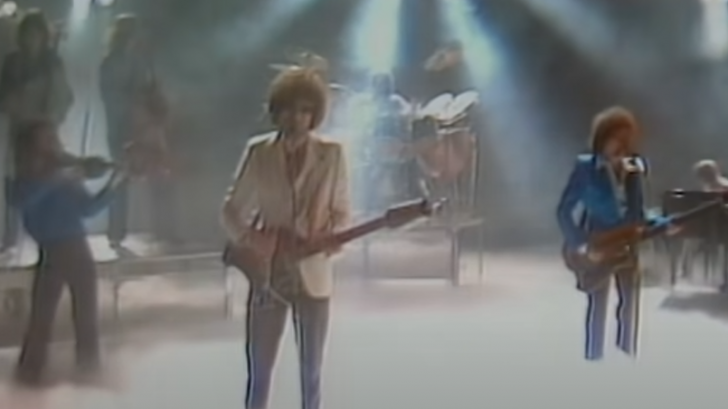Electric Light Orchestra has always been a tough group to categorize. They were really inventive at times, but they always seemed to be aiming for hit singles in the same way that The Beatles and The Rolling Stones did. In other words, they respected content, individuality, and integrity while yet enjoying the art of the pop song.
‘Don’t Bring Me Down’ – ‘Discovery’ (1979)
The final song on ELO’s eighth album is the band’s highest-charting single in the United States. The group’s final iconic song, “Don’t Bring Me Down,” was driven by a marching drum loop. The following year, they recorded the Xanadu soundtrack with Olivia Newton-John, and in 1981, they released the drowsy concept album Time.
‘Can’t Get It Out of My Head’ – ‘Eldorado’ (1974)
The group’s first Top 10 hit and their first significant achievement. ELO were given free rein by Lynne after three albums of stiff orchestral rock with classical overtones, allowing them to go into more melodically modern territory. Eldorado is a concept album, thus parts of the outdated harsh laws still hold true in some areas. But this gorgeous ballad shines.
‘Strange Magic’ – ‘Face the Music’ (1975)
The band’s first Top 10 album has one of ELO’s best ballads, which not only serves as a highlight but also signals a pivotal moment in their career. On the group’s previous album, Eldorado from 1974, they experimented with a few mainstream pop songs before moving on to more radio-friendly material on Face the Music. One of the greatest is this.
‘Do Ya’ – ‘A New World Record’ (1976)
The Move only had one U.S. chart single, “Do Ya” (it stalled at No. 93 in 1971). Five years later, Lynne and ELO performed the same song again, this time making the Top 20. Contrary to a lot of the songs on our list of the Top 10 Electric Light Orchestra Songs, “Do Ya” uses very little classical music. One of rock’s all-time finest guitar riffs is included in the song, one of the band’s heaviest songs.
‘Sweet Talkin’ Woman’ – ‘Out of the Blue’ (1977)
The largest pop eruption from the band’s double-album Out of the Blue may be heard on the fourth track. Before sliding into that one chorus, “Sweet Talkin’ Woman” is all strings, synthesizers, guitars, and call-and-response backup vocals. Additionally, it ranks among ELO’s best ensemble performances.
‘Turn to Stone’ – ‘Out of the Blue’ (1977)
Out of the Blue, the band’s double-album masterpiece, opens with the first single and has a Godzilla-sized hook that crushes everything in its path. An added blast of amazing may be heard throughout the choruses in the form of a brief string symphony.
‘Telephone Line’ – ‘A New World Record’ (1976)
Only “Telephone Line,” the final track from A New World Record to be released, managed to enter the Top 10. A song that combines a timeless melody with a futuristic feel.
‘Evil Woman’ – ‘Face the Music’ (1975)
The band’s transformation from somewhat stuffy art-rockers to a more playful (and significantly funkier) unit occurred with ELO’s breakthrough hit. The band’s customary blend of vintage strings and contemporary keyboards can be heard on the Top 10 single “Evil Woman,” but this time they’re supporting a funky dance-floor beat that propels the song to pop glory.
‘Livin’ Thing’ – ‘A New World Record’ (1976)
Though it peaked at No. 13, the first single from ELO’s sixth album is among the band’s most well-known tracks. Additionally, it has a string-solo introduction, soulful backing vocals, synth waves that periodically smash into the chorus, a huge hook, and a bit of everything else that made them famous. The ending sequence of the 1997 film Boogie Nights included the song “Livin’ Thing,” during which Mark Wahlberg’s porn star whips out his monstrous (prosthetic) penis, cementing its legend. It’s a great moment even though I’m not sure this is what Jeff Lynne had in mind when he penned the song.
‘Mr. Blue Sky’ – ‘Out of the Blue’ (1977)
Over time, the Beatles-like “Mr. Blue Sky” has gained popularity thanks to musicians as various as rapper Common and indie rocker Mayer Hawthorne, who both include it in their songs. The original single only reached No. 35, but it holds a significant position on the two-LP Out of the Blue: It’s the last segment of side three’s “Concerto for a Rainy Day Suite,” and it’s also one of the best-ever vocoder uses in a ’70s song.

